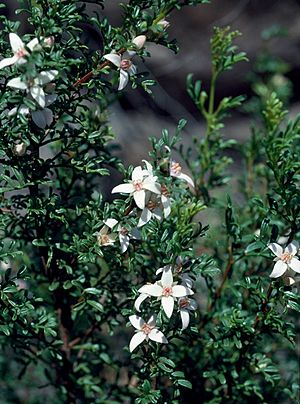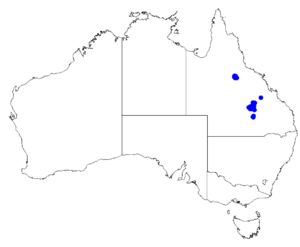Boronia eriantha facts for kids
Quick facts for kids Boronia eriantha |
|
|---|---|
 |
|
| Boronia eriantha in the Carnarvon National Park | |
| Scientific classification | |
| Genus: |
Boronia
|
| Species: |
eriantha
|
 |
|
| Occurrence data from Australasian Virtual Herbarium | |
Boronia eriantha is a special plant that belongs to the citrus family, just like oranges and lemons! It's a type of shrub that only grows in central Queensland, Australia. This plant is bushy with lots of branches. It has leaves made up of several smaller parts called leaflets. When it blooms, you'll see pretty white and red flowers, each with four petals.
Contents
What Does Boronia eriantha Look Like?
Boronia eriantha is a shrub that stands upright and has many branches. It can grow up to about 2.0 m (7 ft) (6.5 feet) tall. Its younger branches are covered in soft, dull white or reddish-brown hairs.
The leaves of this plant are quite interesting. They are "pinnate," which means they look like a feather, with smaller leaf parts called leaflets arranged along a central stem. Each leaf can have anywhere from one to nine leaflets. The main stem of the leaf, called a petiole, is about 2–6 mm (0.08–0.2 in) (0.08-0.24 inches) long.
The leaflet at the very end of the leaf is usually the biggest, measuring about 2–7.5 mm (0.08–0.3 in) (0.08-0.3 inches) long and 1–3.5 mm (0.04–0.1 in) (0.04-0.14 inches) wide. The leaflets on the sides are a bit smaller, about 3–9 mm (0.1–0.4 in) (0.12-0.35 inches) long and 1–3.5 mm (0.04–0.1 in) (0.04-0.14 inches) wide. These leaflets are shaped like a spearhead, wider at the base and narrower at the tip. Their undersides are mostly smooth and hairless.
Usually, you'll find a single white and red flower growing from where a leaf meets the stem. This flower sits on a tiny stalk called a pedicel, which is only about 0.5–2.5 mm (0.020–0.098 in) (0.02-0.1 inches) long.
Each flower has four sepals, which are like small, leaf-like parts that protect the flower bud. They are egg-shaped or triangular, about 2–5 mm (0.079–0.20 in) (0.08-0.2 inches) long and 1.5–3 mm (0.059–0.12 in) (0.06-0.12 inches) wide. The four main petals are larger, about 6–11 mm (0.24–0.43 in) (0.24-0.43 inches) long and 3.5–5 mm (0.14–0.20 in) (0.14-0.2 inches) wide. The undersides of the petals are hairy.
Inside the flower, there are eight stamens, which are the parts that produce pollen. These stamens have special glandular hairs. Boronia eriantha flowers bloom from April to September. After flowering, the plant produces small fruits, which are about 5.5 mm (0.22 in) (0.22 inches) long and 3 mm (0.12 in) (0.12 inches) wide.
How Boronia eriantha Got Its Name
The plant Boronia eriantha was officially described for the first time in 1848 by a scientist named John Lindley. He wrote about it in a journal called Journal of an Expedition into the Interior of Tropical Australia, which was written by Thomas Mitchell.
The second part of its scientific name, eriantha, comes from two ancient Greek words. The word erion (ἔριον) means "wool," and anthos (ἄνθος) means "flower." So, eriantha basically means "woolly flower," which probably refers to the hairy petals or other parts of the flower.
Where Does Boronia eriantha Live?
This type of boronia plant grows in specific areas in central Queensland, Australia. You can find it in woodlands and forests, especially where there is sandstone rock. It grows naturally in places like the Carnarvon Range and White Mountains National Park.
Is Boronia eriantha Protected?
The good news is that Boronia eriantha is currently considered a "least concern" species by the Queensland Government. This means that, for now, there are enough of these plants in the wild, and they are not at high risk of disappearing. This classification is under the Nature Conservation Act 1992.

